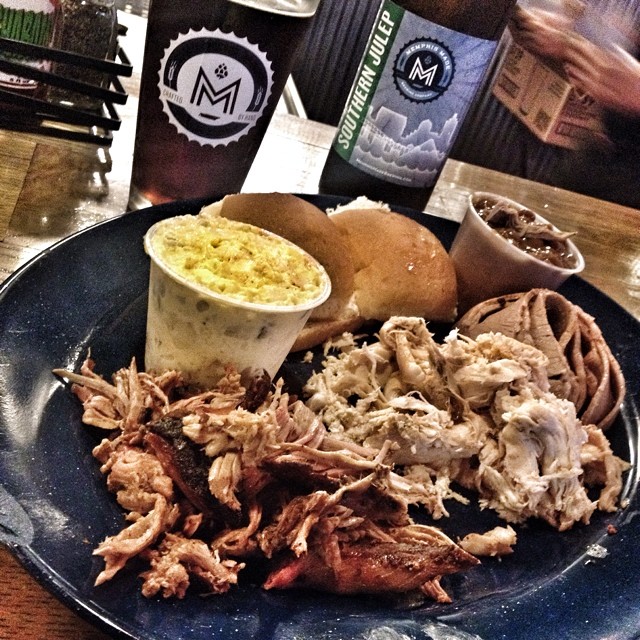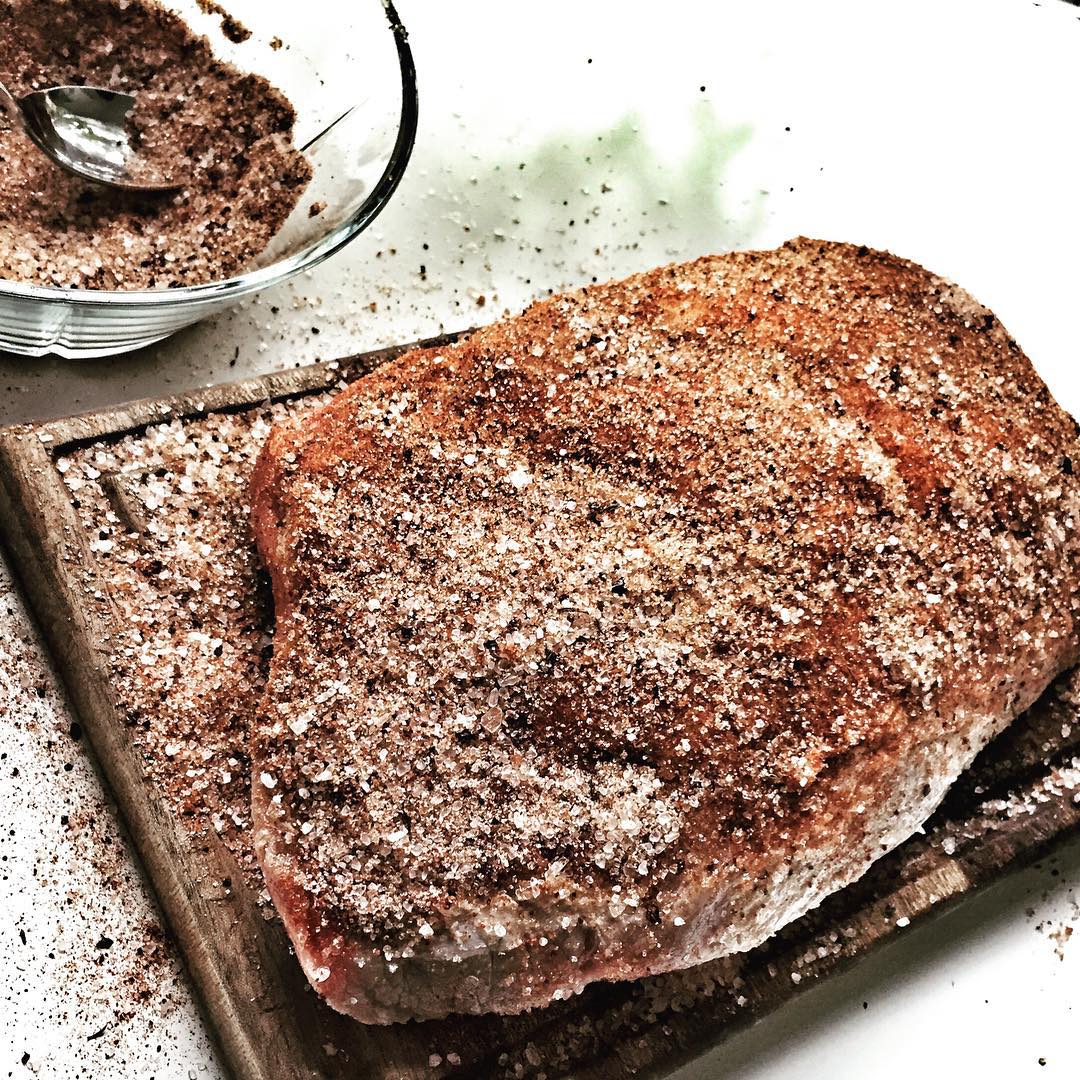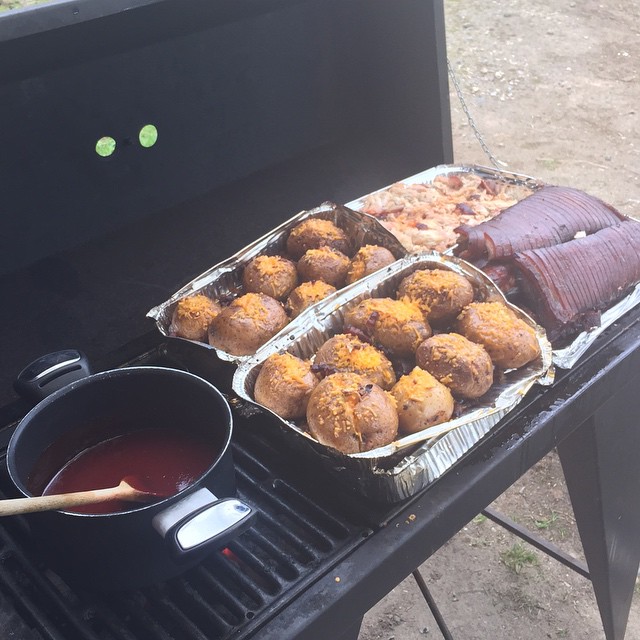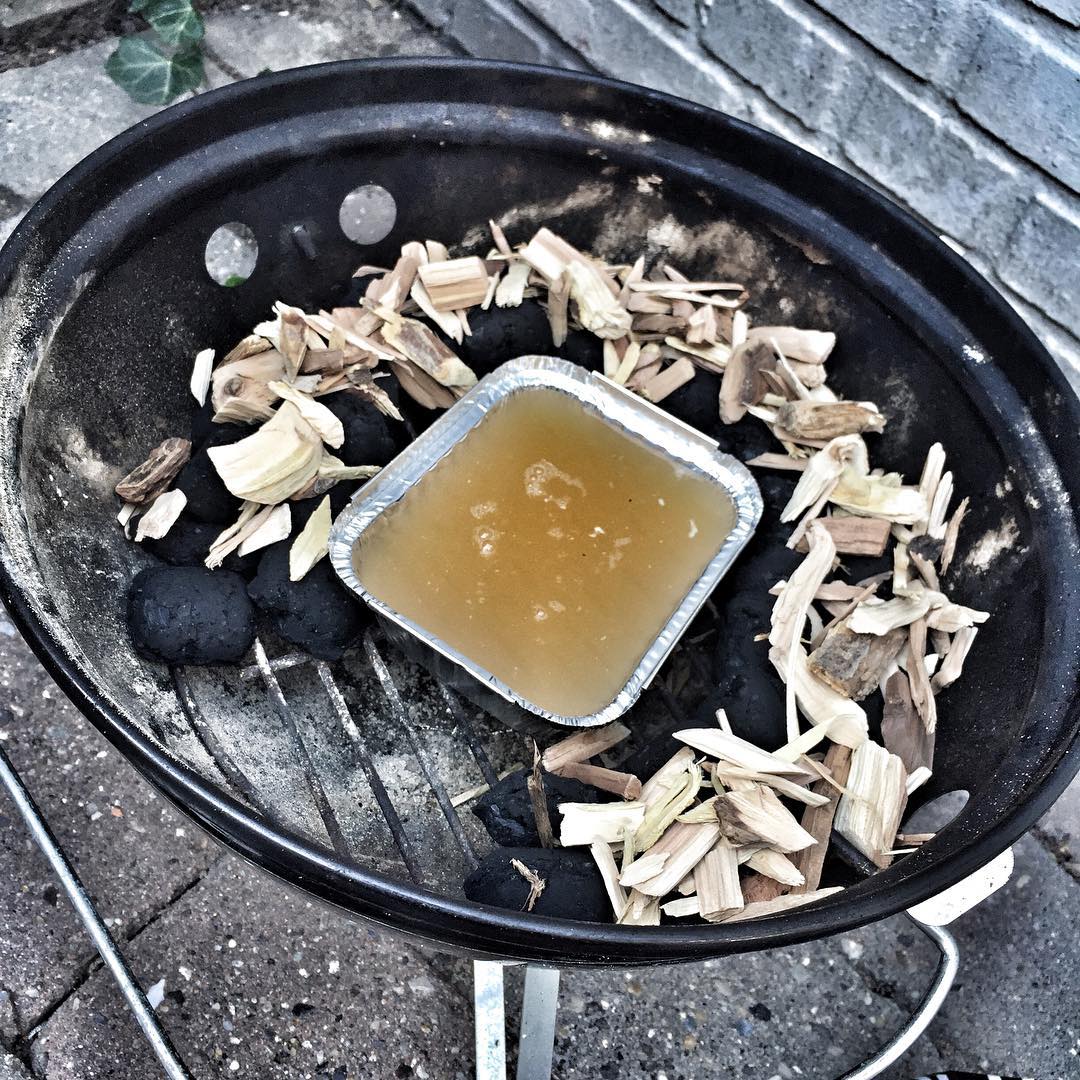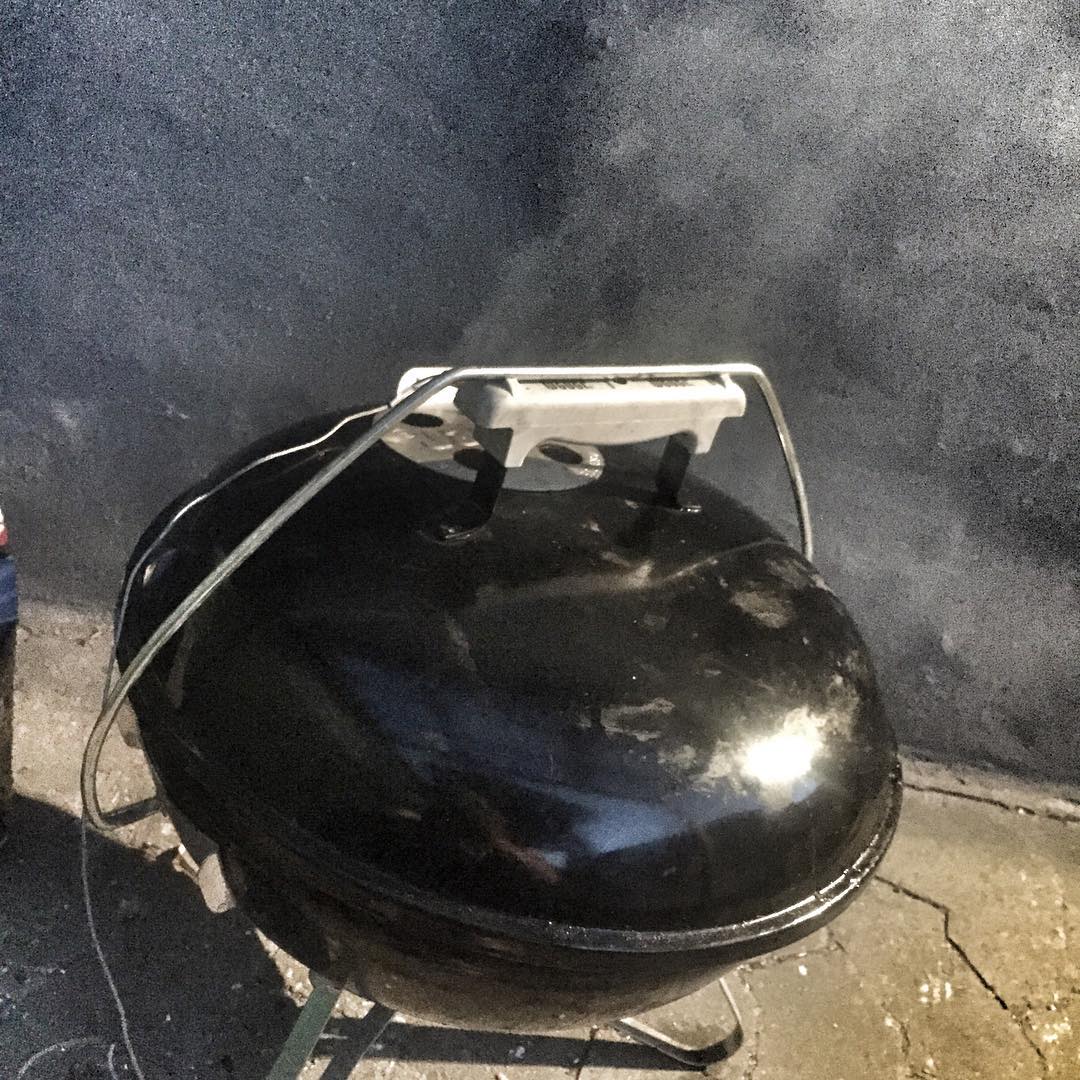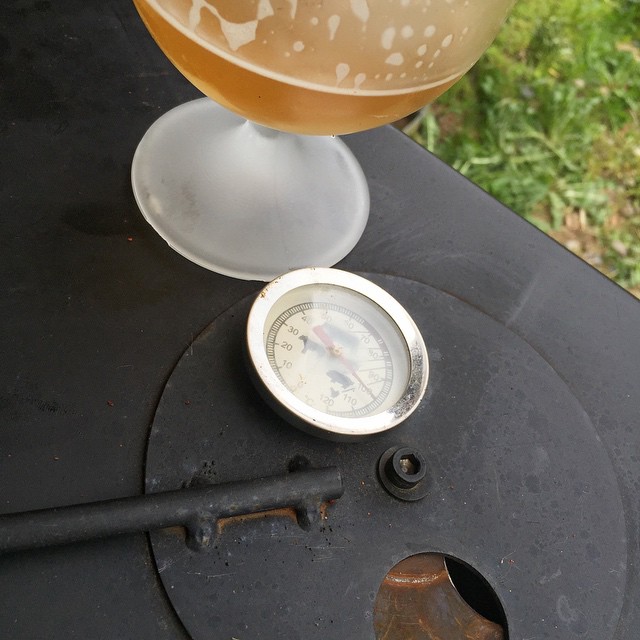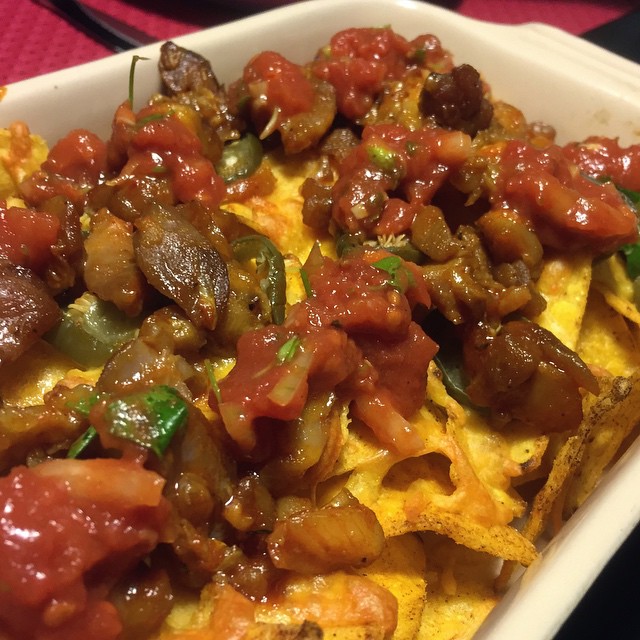For about as long as I can remember, I’ve been fascinated with BBQ. But it is only since last year’s summer roadtrip of the Southern United States that the fascination has been bordering on the obsessive. For more than a year since my return now, I’ve been experimenting, tinkering, taking notes, mixing and matching, subjecting countless friends to more or less sane experiments… All with one simple goal in mind: to create the complete beginner’s guide to perfect BBQ!
Smoke house in North Carolina
Recreating the perfect BBQ experience has by no means been an easy task. I mean, I thought I was pretty obsessive about food and cooking but when it comes to Southerners and BBQ, they really take first price. In Dixie, BBQ is not only a recreational cooking activity, it’s an art form, a competitive sport and, to some, the closest thing you get to a religious persuasion. And they’re good at their favorite passtime! Some of the best, most memorable food experiences of my life took place on that trip, in little run-down shotgun shacks, downing plate after plate of greasy, smoked meat slathered in red, sticky sauce and served with gargantuan amounts of sweet potato fries, deep-fried pickles and BBQ beans… All while washing it down with cheap, local beer, a side of country music or rock ’n’ roll and a beautiful blonde across the table from me.
Yes, life on Earth was pretty f’ing good that summer and that magic has been hard to recreate at home. But I’ve stood my ground, tried my best, laughed in the face of failure and eventually chuckled in triumph when even a particularly culinarily conservative friend looked me deeply in the eyes after eating one of my pulled pork sandwich and confessed: “You’ve ruined this dish for me, I can never again feel this joy from eating it, unless you’ve made it!”
It’ll be a while, granted, before I can square off against the pit masters (i.e. professionals, see below) of the South in the World BBQ championships. But for a scrawny white boy from Denmark, I’d like to think I’ve done good… And that I may have a few things to teach! It is my goal, within the coming weeks, to cover every aspect of BBQ, from the definition over the history to the basics: the spices, the meat, the sauce, the smoke, the sides… Everything! It’s going to be one hell of a ride, but I hope you’ll bear with me. I know I’ve been dying to write this series and I hope you’ll enjoy it.
Homemade BBQ – It may take a bit of time and effort, but it’s damn well worth it!
To get started, let’s set the mood and talk a bit about what BBQ is and what BBQ isn’t, the history of BBQ and some of the basics. It may seem a bit lengthy, but it’s only through properly understanding BBQ and its basics that we can understand why so many people are so incredibly obsessed with this particular style of cooking.
BBQ basics: What is BBQ not?
Before we gaze at the wonderful world of BBQ, let’s clear out a few common misconceptions about what constitutes BBQ. A lot of people will fire up a grill, bring friends over, have a few beers, grill some steaks and tell people they’re having a BBQ… And that’s all well and fine. Only, they’re not, they’re having a cookout or they’re grilling, they’re not BBQ’ing.
Neither is BBQ a potato chip flavor, a type of sickeningly sweet tomato-based sauce or a term that can be used to describe pork shoulder that has been seasoned and cooked in the oven. No, friends, BBQ is something much more special than those more or less reasonable approximations of the concept and I’m here today as the likeable food snob that I am to set things straight and to tell you once and for all that BBQ can mean two things and two things only!
BBQ basics: What IS BBQ?
BBQ first and foremost can be used as a verb to describe the process of slowly cooking one or more types of meat over indirect heat using smoke as a main flavor ingredient. Or it can be used as a noun to refer to the product of the BBQ cooking process.
Why such snobbery and attention to definition? Because BBQ, quite simply put, is one of the most underrated traditions in the culinary world and because BBQ, through hard work, dedication and a lot of time can create flavors like no others and may even elevate even the cheapest, toughest, most humble cuts of meat to culinary perfection.
Much like the comparatively simple albeit still admirable act of grilling, BBQ takes thought, understanding and effort… But unlike grilling, it takes time… As in anything from several hours to several days to prepare one simple dish, and anywhere from several years to a lifetime to truly master the trait. Like grilling, BBQ can be a social event and a bit of a lifestyle, but, again, unlike grilling, it’s more than just a lifestyle. For the true masters of the trade – the Pit Masters as we aficionados respectfully refer to them as – it’s nothing short of an art form and when done right, the results are magical and much more intensely complexly flavored than anything you’ll ever get off a grill.
And much of that complexity comes, indeed, from smoke, slow gentle, cooking, understanding of the meats we play around with and a heck of a lot of preparation and thought.
Which is why, ladies and gentlemen, we are devoting an entire series of posts to the subject, starting with the very history and basics of BBQ and leading us, over the course of the coming weeks, through creating our own mouthwatering home-versions of a couple of BBQ classics and side dishes.
Barbacoa – The Origins of Barbecue
As with so many great foods before it, the origins of BBQ are shrouded in mystery and myth. The prevailing theory seems to be that the word Barbecue is derived from the age-old Spanish/European term Barbacoa or Barbecoa which was used to describe a certain cooking technique favored by native tribes in the Caribbean. Upon landing in 1492, Columbus and his men reported seeing natives spit roast large chunks of animal meat over a grill consisting of a wooden framework resting on sticks with a fire underneath. The natives called this cooking method barabicu which then, legend has it, warped into barbecoa and onwards into the modern Barbecue or BBQ.
Whether the above is to be considered fact or legend, modern Barbecue certainly shares some very common traits with the ancient barabicu cooking methods, and it IS interesting to note that Barbecue tradition is especially prominent in areas of the US that had strong Caribbean influence over the years. But while the similarities and tires are certainly there, the taste, culture and complexity of Barbecue has certainly evolved a lot since its supposed roots in native cooking of the Caribbean.
BBQ in the 21st Century
In its simple form, Barbecue today describes a variety of seasoned meats, cooked for an extended period of time, either over hardwood or a combination of briquettes (or other heat source) and hardwood using the smoke from said hardwood as a *major* flavoring agent in the final dish.
The problem with such a broad definition is that it is usually up for interpretation and interpretation is EXACTLY what happened to Barbecue over the years. With quite a bit of controversy and bickering to follow. Ranging from bitter debates about which meats or cuts of meat to use, which vessel to cook them in, whether and how long to season the meat before cooking, which cooking medium to favor, how much smoke to apply during the cooking, which type of wood to use… and last, but by no means least which type of seasoning or sauce to use as a finishing touch – if indeed a sauce is to be used at all! With every self-proclaimed expert sticking to their own opinions.
As you can probably tell, dear reader, we’re entering a pretty dangerous world of highly opinionated individuals, so rather than giving a short definite answer to what constitutes perfect BBQ, let’s start by having a (brief) look at the various components that constitute modern BBQ.
BBQ Basics, no 1: BBQ friendly cuts
When it comes to BBQ, there are technically no limitations as to which type of protein can be used. Primarily, though, BBQ meat falls into one of two categories: pork and beef. No matter the type of meat used, though, usually fattier, tougher and hence slower cooking cuts are preferred. Not because barbecue is poor people’s food (though originally it probably was), but simply because fatty and tough cuts stand up better to the longer cooking times that are needed for the smoke to do its magic.
What cuts are popular, then? Well, for pork, the pit master cuts of choice usually include ribs or pork butt – that is just another funny word for pork shoulder, get your mind out of the gutter, people! – while in some areas, like the Carolinas most famously, the rather complicated process of whole hog BBQ is not only traditional but also quite appreciated.
For beef, the selection process is generally a little easier. Here one cut rules supreme: brisket, a fatty, chewy, breast cut of the critter which, believe it or not, can be turned into the most tender, succulent and flavorful piece of beef you’ll ever have, given enough time and tender, loving care.
Beef, pork, chicken, alligator… Why choose? Anything can be BBQ, really.
Less common BBQ meats include chicken, sausage (technically pork and/or beef), hamburger (popular in Kansas, believe it or not), duck, lamb, even alligator (so good!) and other commodities. The real stars of the circuit, though, remain the same: brisket, pork shoulder (pulled or chopped) and ribs. These are the types of meats that have shown over time to benefit most from the Barbecue cooking process and these are the types of meats that pit masters across the US compete to perfect in a myriad of ways by tweaking such factors as seasoning, time, temperature, smoke exposure and smoke type, and, lest we forget, sauce – or no sauce.
BBQ Basics, no 2: It really starts with a rub
Most, if not all, meats start their road to BBQ stardom being coated or smothered in what is generally referred to as a rub. A rub is basically a mix of herbs and spices such as salt, pepper, sugar and, well, everything nice: cayenne, chili power, garlic powder, paprika, chipotle… You name it!
A rub can be either dry (made exclusively from dried herbs and spices) or wet (when some – or large – quantities of liquid are used) and it can be as simple as just a sprinkling of kosher salt or as complicated as an intricate mix of up to 27 different herbs and spices (that’s the most I’ve heard of, anyway).
Rubs are usually applied to meats well in advance of the cooking process and are used to provide both flavor and color to the finished BBQ meat. Most famous amongst rubs are the dry rub, a largely complicated, often secret, proprietary mix of spices which varies from cook to cook and is used to impart a personal touch and flavor profile to the finished product. The dry rub is the heart, soul and price of any BBQ cook and the exact composition of these very personal rubs are usually kept a well-guarded secret. This may seem a bit weird to outsiders, but considering that many cooks have spent years of their lives perfecting their rubs and the fact that BBQ is actually a pretty competitive (sport) hobby with official cook-offs, World Championships and cash prices, it all does make a weird kind of sense.
It all starts with a rub…
… Does that mean I’ll keep you in the dark and not tell you how to make a great dry rub? Of course not. We’re all friends here and I don’t let friends hanging! As a matter of fact, if you stick with me, I’ll promise to do what no other BBQ authority would ever consider: I’ll share with you the secret of my dry rub! But that’s another post… For now, all you need to know is that BBQ starts with quality meat, a dry rub and some time for the flavors to sink in before we move on to…
BBQ Basics, no 3: The belly of the beast: the BBQ Smoker
The heart and soul of any BBQ operation, be it large or small, is THE SMOKER, an enclosed environment capable of fitting not only the meats to be prepared but also the heat source over which to prepare them and the smoke source with which to flavor them. Depending on the scale of the operation, a smoker may be everything from a kettle grill over professional smokers to homebuilt rigs or even entire smoke houses.
Large restaurant smokers, by the way, are usually referred to as pits owing to their enormous size. The people who tend them are known as pit masters, a titel that is usually earned through decades of hard work and worn with no uncertain amount of pride! The title of pit master, essentially carries the same amount of pride to a Southerner as the title Chef does to the commander of a NYC kitchen.
The purpose of any smoker, regardless of size, remains the same: To be able to comfortably fit your desired quantity of meat while offering enough space, airflow and reliable temperature control to gracefully cook and smoke your meat over low and slow heat for an extended period of time until it is bursting with hot, smoky flavors and is absolutely falling apart tender.
BBQ can easily be a small scale operation – or not! Here’s me doing pulled pork for 40 odd people.
The real beauty of BBQ is that anything, really, can be a smoker. You really don’t need much in terms of special equipment to get started as long as you’ve got a bit of patience and determination. I’ve managed to produce BBQ on everything from tiny, portable kettle grills, to huge, custom build rigs capable of fitting half a pig at once. All you really need is an enclosed environment with an adjustable airflow, some decent charcoal briquettes and some wood chunks and you’re pretty much good to go. A kettle grill such as the Weber industry standard, is perfect for the job if you’re cooking for ten people or less – but almost anything, smaller or larger, will do just fine. You can even, if you’re certifiably insane, chose to use a propane grill with a smoking insert.
As we shall see in a later post in this series, what matters is not so much the shape and size of your smoker but rather that it fits what you’re trying to cook as well as a slowly and steadily burning heat source and a smoke source to produce the hallmark of good BBQ: a wonderfully deep, intense, smoky flavor. And speaking of smoke, few people really pay much attention to this part of the equation which is odd, considering that smoke is actually the most prominent flavor of real, honest to God BBQ. So, let’s dwell a bit on the subject of smoke, shall we?
BBQ Basics, no. 4: Got wood? BBQ and the essence of smoke!
Smoke, as I’ve just claimed, is the major flavor component of real BBQ. Sure, the spices in most modern dry rubs are prominent and welcome players in good BBQ, but it’s the underlying, intense yet integrated and soothing smokiness that really makes BBQ, well, BBQ.
Smoke wood! This is apple, for apple-brined pulled pork. The murky liquid in the middle? Excess brine to provide moisture during smoking.
And even if you may think it a pretty trivial subject, the type of smoke used in BBQ is not exactly unimportant. Au contraire, mes amis! See, different kinds of wood have slightly different aroma and flavor profiles and since BBQ generally involves subjecting pieces of meat to smoke for extended periods of time – often upwards of six hours or more – these subtle differences often become quite pronounced. But which wood should you chose given the luxury of choice? Well, here’s a very quick guide to some of the most common types of smoking wood and their subtle differences:
Hickory: Probably the most common of smoke woods and the easiest to find. Hickory imparts a strong, slightly sweet heavy bacon-like smoke flavor that works well with pork, beef, poultry, well, anything. Really. Hickory is a pretty good all-round smoking agent but easily becomes overpowering and bitter if burned too hot or used in too large quantities.
Mesquite: Another very common smoke wood, has a strong earthy flavor that is sweeter and more delicate than hickory. Mesquite is the perfect accompliment to richly flavored meats such as beef, duck and lamb.
Oak: Oak, rather surprisingly, given its heavy impact on spirits aged in the stuff, imparts a mild smoke flavor with no considerable aftertaste. As with spirits, though, it adds a quite a bit of attractive color to the meats smoked over it. Oak is particularly good with beef brisket or even game.
Apple: Apple wood has a slightly more subtle, more perfumed and lightly fruity smoke note than oak or hickory. It doesn’t so much taste of apple as it tastes not of oak or hickory. It’s a lighter, less pungent smoke note that works really well with lighter, white meat, such as pork or chicken. As a matter of fact, I smoke much of my pork over apple wood.
Bourbon/Whisky: As the name suggests, this type of smoking wood comes from repurposed Bourbon or Whisky casks. These casks are made of oak and hence carries some of the pungency of regular oak chips. At the same time, though, these particular pieces of woods have been soaked through with Bourbon/Whisky for years and years which have given them an incredibly complex fruity and Whisky-like quality which easily transfers over to whichever meat you smoke over them. In Scotland, spent Whisky casks are used for hot smoking salmon, but pork and even beef are good choices as well. Pulled pork smoked over Bourbon smoke chips is pretty much to die for.
For an even more comprehensive, geekier and, quite frankly, impressive comparison of the characteristics of smoking wood in BBQ, check out the Wood Smoking Flavoring Chart from deejayssmokepit.net.
Some resources will tell you that the type of wood isn’t really important. I personally respectfully disagree here. I think that with enough time, the subtle characteristics of the wood used do shine through to a true BBQ aficionado. On the other hand, though, I also agree that you should not let lack of a specific kind of wood keep you from firing up the smoker. You can easily substitute hickory for apple or mesquite for oak, but the subtle differences are there and they’re worth experimenting with once you’re hooked.
What matters more than anything when dealing with BBQ is not the type, but the amount of smoke wood used and the temperature and speed with which it burns. A common mistake in an effort to do well amongst BBQ beginners is to use too much smoke wood and pile it on too aggressively. Please don’t. If you use too much wood, your meat will be overstocked and take on a stale, bitter taste. If you smoke it too aggressively, i.e. let the wood get so hot that it starts smoking aggresively or even catching fire, your meat will be left with an undesirable off-taste of soot and tar. We will be talking in much more detail about the art of smoking in a follow-up post, but for now here’s a crash course in what you need to know about smoking meats:
Generally speaking, for smaller, thinner pieces of meat: fish, pork chops, sausages, 30 – 60 minutes of smoking is ideal. For larger all day (or more) projects like pork shoulder or beef brisket, which often involve 10-16 hours of cooking time, I would say that 6-8 hours of smoke does the trick. Incidentally, smoke wood come in different shapes and forms: usually dust, chips and chunks. Smoking dust (saw dust, basically) smolders rather quickly, releasing a relatively large amount of smoke in little time, ideal for fish and smaller meats. Wood chips smolder slower, giving off a slower, more controlled amount of smoke – ribs anyone? Large chunks, obviously, burn the longest and the slowest, perfect for those succulent big chunks of pork shoulder or beef brisket.
If you have the comfort of variety, there’s good reason to pick a shape that matches what you’re planning to cook. And once you’ve picked a shape, there’s good reason to think about how you add it to your smoker. You see, in terms of BBQ, smoke isn’t just smoke, there are two types of smoke: good smoke and bad smoke. Good smoke comes from a slow, controlled burn and contains all the desirable flavor and aroma elements of good BBQ. Bad smoke is black, sooty and pungent, the result of a quick, uncontrolled burn. Ideally, when cooking BBQ, you’ll want to see a white to subtly blue jet of smoke rising from the smoker through the course of the smoking process. White smoke, in both BBQ and Papal conclaves is a good sign black smoke means you’re doing it wrong and that undesireable flavors are trying to crash the party.
Me and my Smokey Joe weathering a nightly thunderstorm. See that blueish white smoke rising against the backdrop? We call that good smoke!
The way to achieve good smoke over bad smoke is painfully simple but does require some attention and foresight. First and foremost you need to keep the temperature of your fuel source (charcoal or, God forbid, propane) low and controlled throughout the smoking process and you need to keep your smoking agent as far as possible from direct heat so that it doesn’t start smoking too aggressively – or, worse yet, catch fire. If you’re using smoking dust, pour it into an aluminum tray and place it either on top or next to the coals, if you’re using larger pieces of smoke wood, place them close to but not directly on top of the embers. Avoid the common temptation to soak wood before using. This, too, will cause aggressive, impure smoke.
If this all sounds a little complicated, it’s probably because it isSmoke control is probably the hardest part about BBQ and is a skill that may take some trial and error, I’m not gonna lie to you. But you should not let that keep you from trying. A little bid of bad smoke won’t ruin anything. Keep an eye on the smoker during cooking and if you see a lot of black smoke starting to form, vent it out and get back on track. With a bit of time and patience, you’ll get perfect results. And speaking of time and patience, here are a few more key ingredients of proper BBQ. In fact, while smoke is easily the most important ingredient of good BBQ, you may be shocked to hear that time (and patience) is probably the second most important ingredient.
BBQ Basics, no. 5: Time – the second most important ingredient
There is, quite simply and absolutely, no rushing good BBQ. Not in the preparation, not in the cooking. BBQ meats, whether big or small, need to be cooked over a low, steady heat source. Not only to allow the smoke flavors to fully penetrate the meat, but for other reasons as well. Firstly, if using a tough cut of meat – as is usually the case when it comes to BBQ – time and low, steady heat is needed to slowly break down the fat and connective tissue in the meat to render it succulent, juicy and tasty. Secondly, and equally important, the dry rub which we coated the meat with prior to cooking needs time to slowly melt, caramelize and eventually solidify into a deep, dark flavorful crust that we in BBQ terms refer to as the bark. If we go too aggressively on the heat, the sugar and spice contents of the dry rub will burn rather than caramelize and we’ll be left with a burnt, ashy flavor. No one wants that.
Minding the smoker doesn’t have to be all work and no play… Not by a long shot!
In a perfect world, the temperature of your smoker should not exceed 99C and the cooking time should be based on the weight and shape of the meat cooked, not by modern factors such as convenience and set dinner times. When done, your meat should be fragrant, flavorful, juicy and falling apart tender, ready for the biggest choice/controversy in the world of BBQ.
BBQ Basics, no. 6: Sauce?
To the average European, the topic of BBQ sauce may well seem pretty straight forward. In our world, BBQ is usually served with a bright red, thick, sweet and sometimes spicy concoction known simply as BBQ sauce.
However, in the wondeful world of (real) BBQ, sauce is actually a topic of heated debate and unbelievable controversy. Purists will argue that real BBQ needs no sauce at all! A sprinkle of dry rub and a few drops of vinegar at the most, maybe a careful slathering of oil, but no more. Others will argue that sauce is a basic human right and that no BBQ platter is complete without sauce… And that’s when the debate begins. Should the sauce be sweet? Hot? Tomato-based? Vinegar-based? Thick? Thin? With or without mayo (no, seriously, in Alabama, that’s a thing!)? It’s a jungle out there and to each their own.
To tell you the truth, many are the times where I’ve just tossed a perfect batch of pulled pork in a bit of apple cider vinegar and a sprinkle of left-over rub and called it a day. Very happily so, I might add. But if sauce is what you want, sauce is what I’ll give you… But that’s another post, of course. For now, here’s my view on sauce: Since BBQ is such a heavy, complex, smoky flavor with a lot of spice, even sugar, already present in the rub, I steer clear of sweet, heavy tomato-based sauces. To me, it just gets too much. I need something to counteract the richness of the meat. I need me a bit of Carolina-style punch! I prefer to have my sauces leat with a pungent but controlled vinegary punch, followed by a clear bite of chili heat and trailed with an underlying, controlled sweetness. My sauces are usually to pungent for some on their own, but mixed with the sweet, spicy, succulent meat, they work for every diner. And they’ll work for you, too. But as I said, that’s another post.
The Gospel of BBQ according to Saint Everybody
As you read this description of what BBQ is and isn’t, you may be getting the impression that opinions on the subject vary. And, uh, you’d be right! Opinions of what constitutes proper BBQ will vary from person to person and from one geographical location to another. In fact, over the years different regional styles of BBQ have evolved in the US, even across the world. Certain loosely defined geographical areas in which particular traditions, processes and variations have become the norm and have created precedence for how BBQ in that area should look, smell and taste. Of course, being Danish, I don’t have to stick to any specific set of rules and can borrow whichever elements I chose from the various styles. But still, a few distinct styles bear mentioning, namely the big four:
Carolina style BBQ: Carolina Style BBQ is all about pork. Usually pork shoulder, pulled or chopped, but some places in South Carolina, whole hog BBQ is an honored tradition. Traditional Carolina-style sauces are usually hot, tangy and loaded with apple cider vinegar. The combination of fatty, juicy, rich pork and tangy, vinegary sauce is a personal favorite of this humble food blogger.
Kansas City Style BBQ: Kansas City BBQ isn’t so much a BBQ style in itself as it is a combination of styles. Drawing on BBQ tradition from across the country, Kansas City BBQ usually means a large variety of different meats: pork, beef, sausage, chicken, even hamburgers served together with a side of fries (the horror!) and generous amounts of red, usually tomato-based, sauce.
Memphis Style BBQ: In Memphis, they like their ribs and they serve them two ways. Wet or dry. Wet ribs have been basted with sauce prior and after cooking whereas dry ribs have been sprinkled with a dry rub instead. Aficionados will usually tell you to go for the dry ribs. A curious thing about the people from Memphis is their culinary daredevil willingness to mix BBQ with decidedly non-BBQ dishes such as spaghetti pizza and even nachos. BBQ nachos, by the way, are ridiculously good! Believe me!
Texas Style BBQ: Texas Style BBQ is about one thing and one thing only: beef! With Texas being home to so many mind-bogglingly huge cattle farms how could anything else be the case. In Texas, brisket rules supreme and both portion size and smoke rig size follow the general rule in Texas: Go big or go home!
Not yet confused? There are dozens, if not hundreds of other regional styles. For the most updated list, Wikipedia probably has the answer.
BBQ Nachos! In Memphis, it’s a thing! And they’re awesome!
To sum up. BBQ is large, often tough, cuts of meat, usually pork or beef, cooked in an enclosed environment over low heat for extended periods of time using smoke as a major flavor component. Before cooking, BBQ is usually heavily seasoned with a dry rub consisting of a myriad of spices, and after cooking quite often drizzled with a sauce that is either tangy, sweet, hot or all of the above. Doesn’t sound too terribly confusing, does it? It does?
Well, fear not. Watch this space in the coming weeks where we will slowly but steadily walk you through the process of creating a BBQ feast, starting with the dry rub, moving over the meat and the smoking procedure to the saucing and even the side dishes.
UPDATE: Part II of The Beginner’s Guide to BBQ is now online, read it here!


